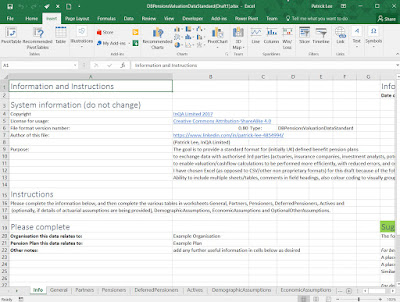I have long thought it would be useful for there to be a standard format for exchange of data files for DB (Defined Benefit, i.e. final salary or career average revalued) pension plans, at least in the UK initially. This would make it easier for pension plans to share information (with actuarial consultants, but also other advisers e.g. buyout companies, investment analysts), not just in mergers and acquisitions, but also in risk transfers (longevity, or pensions buyouts) and would improve the comparability of analysis across companies by investors etc. It should also reduce costs for trustees and plan sponsors, and may increase the quality of the data held. I think this both with my InQA hat on (I declare an interest in that our pensionsconcerto.com product would be well placed to use such a standard), but also from the point of view of being an improvement for the pensions industry generally. Investment banks have standard formats for exchange of information abo...




